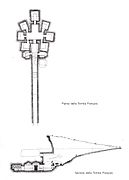Tomba François
The Tomba François ("François grave") was found in 1857 by Alessandro François and Adolphe Noël des Vergers near the ancient Vulci and quickly became famous for its well-preserved frescoes , the inscriptions of which are mentioned by some historically transmitted people. The paintings themselves are also considered masterpieces of Etruscan wall painting . The grave dates to the 4th century BC. When Vulci was already under Roman rule after its capture in 396. Shortly after the discovery of the tomb, the paintings were removed from the wall and brought to Rome ( Villa Albani ). There are copies on site today.
The tomb has a long dromos that leads into a main burial chamber. Behind it is another burial chamber around which nine other, smaller chambers are arranged. The plan is reminiscent of a house, with the main chamber as an atrium , the second chamber as a tablinum and the smaller burial chambers as bedrooms (cubicula).
The most elaborate paintings are in the main burial chamber. There is a painted meander frieze near the ceiling and an animal frieze underneath. The main walls show large figures, mostly standing alone or arranged in pairs. They can be identified by writing on them. Some of the figures themselves are not well preserved. There is a mixture of mythical and real people. Among the mythical figures are Sisyphus , Eteocles and Polynices , who kill each other, and Ajax , who rapes Cassandra . There is also a depiction of Vel Saties, who had the tomb built. There were probably benches at the base zone, but they are no longer preserved today. In the main chamber, Camillus , the so-called second founder of Rome , is also depicted killing Gaius Tarquinius of Rome. Camillus is known as a historical person, but it is uncertain who is meant by Gaius Tarquinius. Indeed, there were two Etruscan kings in Rome from Tarquinia , but none of them were named Gaius. Both kings lived in the 6th century BC. BC, while Camillus was politically active over 100 years later.
The paintings in the second chamber follow a different scheme. In the uppermost zone there is again a meander frieze, but there is no hunting frieze below. In the base zone there are benches, which have also been preserved here. The two main walls each show large-scale scenes, whose actors can in turn be identified by inscriptions. On the left wall you can see Achilles sacrificing the Trojan prisoner at the stake of Patroclus . On the right wall there are fights between two men. The inscriptions make sure that Etruscans are depicted, but an indication of origin is only provided for the losers. It was therefore assumed that the winners each come from Vulci and therefore did not need to be identified separately.
In the corner to the back wall is the most noticed scene of the tomb. Here two men are depicted on two walls, across a corner. One of them is Mastarna (here Etruscan : Macstarna), who liberates the other, Caelius Vibenna (here Etruscan: Caile Vipinas). From a speech by the Emperor Claudius it is known that Mastarna was the Etruscan name of Servius Tullius , the sixth king of Rome , who in turn is passed down as a friend of Caelius Vibenna. The information in Claudius' speech is thus confirmed by the paintings in the tomb.
literature
- Nigel Spivey: Etruscan Art. London 1997, ISBN 978-0-500-20304-0 , pp. 153-158.
- Jean Gagé: De Tarquinies à Vulci. Les guerres entre Rome et Tarquinies au IVe siècle avant J.-C. et les fresques de la Tombe François. In: Mélanges d'archéologie et d'histoire publié par l'Ecole française de Rome. Volume 74, 1962, pp. 79-122 ( digitized version ).
Web links
Coordinates: 42 ° 25 ′ 2.6 ″ N , 11 ° 38 ′ 20.8 ″ E





